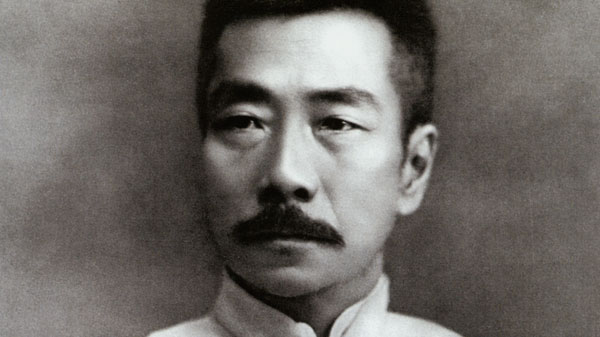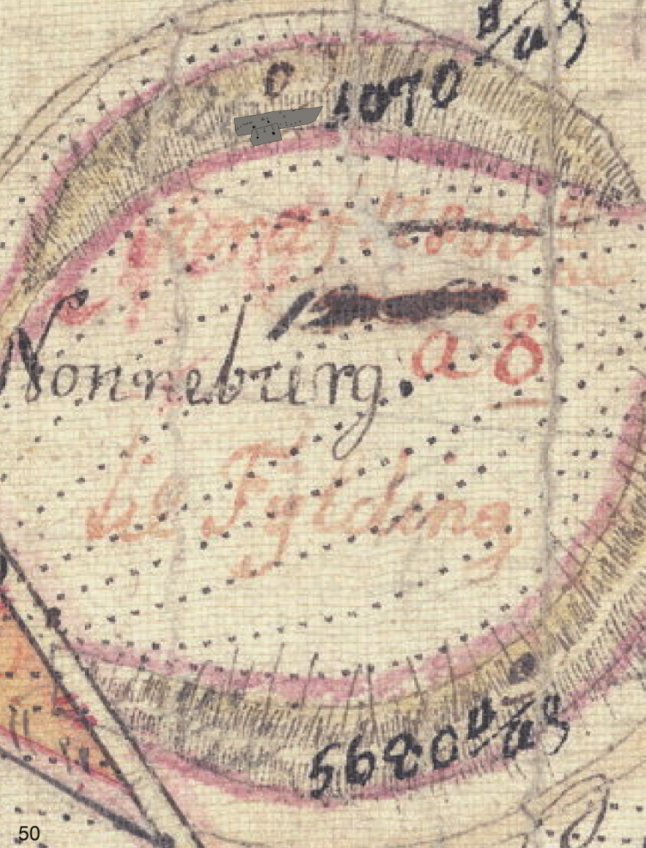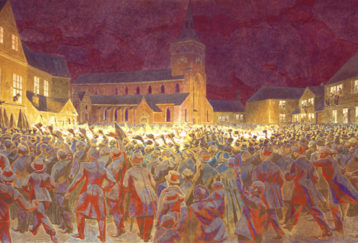
Since my early childhood, I have deeply cherished the beautiful fairy tales of the great Danish writer Hans Christian Andersen. Fairy tales such as The Little Mermaid, The Emperor’s New Clothes, The Ugly Duckling, The Little Match Girl and so on. Those fabulous tales added color and happiness into my lonely and dull life as a little Chinese girl. Those fairy tales are full of the power of rich imagination and vivid descriptions and wonderful plots, emitting the fragrance of the green island, and makes me fascinated still today whenever I recall my reading in my early childhood.
Andersen s name is widely known in China. Everybody knows that he is one of the greatest writers in the world. Moreover, Andersen’s fairy tales have influenced Chinese readers for several generations. He is for us not only a writer of fairy tales, but also a poet, a dramatist, a traveler and even an artist of paper cutting. We admire him for his brightness and versatilities.

Among Chinese writers, Lu Xun (1881-1936) has always ranked as number one in the modern history of Chinese Literature. Many Chinese like this comparison: “It is the pride of the British that they have a Shakespeare who can never be talked about enough; similarly, it is the pride of the Chinese that we have a Lu Xun who can never be talked about enough.”[1] However, until now, few people have compared Lu Xun and Andersen and studied the two authors in comparison with each other. Actually, although the great Danish writer Andersen and the great Chinese writer Lu Xun have many differences they have even more similarities. Both of them are authors with universal fame, both of them have their own profound and well known masterpieces which have been translated into many different languages of the world. Consequently, a comparative study of their authorship is therefore meaningful. In the following, I will try to compare the two authors just as a preliminary study.
In China, Lu Xun was – like Andersen – also the pioneer for advocating for children’s literature. He not only called for the introduction of western literature for children, but also collected and translated the stories for children himself.
In the middle of the 19th century, the unique cultural thought and literary art from Northern Europe attracted the world’s attention. At that time many modern writers and artists in China were influenced by the Scandinavian culture, absorbing some spiritual nourishment from it. As early as the beginning of the 20th century when Lu Xun studied in Japan, he had already paid much attention to collect and read all kinds of books from Northern Europe. According to records, more than 50 German editions of Northern European books were bought and read by Lu Xun while he was living in Japan. Among those books, there were 19 Danish books – including 7 of Andersen’s works, for example the Collection of Andersen’s Fairy Tales in 10 volumes, Picture Book Without Pictures, Andersen’s autobiographical novels such as Lucky Peer, A Poet’s Bazaar, Only a Fiddled, O.T. and To Be, or Not to Be, etc.[2] Lu Xun had almost collected and read all of Andersen’s books, published and translated then. Besides, Lu Xun was interested in collecting and reading the Danish philosopher Søren Aabye Kierkegaard’s books such as his Forførerens Dagbog and some other posthumous manuscripts edited by others.
Lu Xun paid much attention to the translation of foreign literature very early. In 1909 Lu Xun edited and published Collection of Foreign Stories in cooperation with his younger brother Zhou Zuoren. The general editor responsible for the final version of this book was Lu Xun. The selection of the stories for translation was the embodiment of his continued aim of translation – to purloin the fire from the West, to light the dark house of our own, just like Prometheus. In this collection of translated stories, “The Emperor’s New Clothes” by Andersen was included. This was the first time a fairy tale by H.C. Andersen was translated into Chinese. Lu Xun’s preference for fairy tales was also reflected in 1926 by his own translation of Little Johnny by the Dutch author Frederik van Eeden (1860-1932) (from a German edition).
From the Lu Xun brothers’ translation and publication of foreign tales, a variety of all kinds of Andersen’s books appeared in China, until the fascinating stories of Andersen became widely known and loved by both children and adults. As early as in the year 1919, Lu Xun already had put forward the celebrated proposition How should we behave as Fathers. Thus, a new era in China’s literature for children was initiated. It was by Lu Xun and some other pioneers’ efforts “children” were rediscovered and were paid considerably attention to ever since.
When talking about the approach towards children, Lu Xun and Andersen are similar to each other. As pioneer and advocator for children’s literature, Lu Xun had many thoughtful ideas and talks. He paid much attention for improving the education for children in China. Once he said: “If you don’t treat the kids as human beings when they are young, they will never be men when they grow up.”[3] From this point of view he illustrated his opinion that it is from the education of children that man’s dignity and personality are established.
Since 1909, when Lu Xun and his brother introduced Andersen’s fairy tales into China for the first time, Andersen had gradually become one of the most influential foreign authors of the century in China. Along with more and more of his translated works Andersen’s fairy tales had become the most popular ones and occupied the most important position for improving the development of children’s literature in China. The themes of love and beauty, the sympathy for the humble and the weak, the lyric language, the warmhearted tone, the lofty artistic quality, as well as the techniques of personification of animals and plants, the exaggeration, the sense of humor – all were admired by the readers and touched both the children and adults immense. Andersen’s fairy tales had obviously offered new types of models and references for contemporary literature of children and became basic patterns of the new literary creation in China. The study and the references of Andersen’s fairy tales had become important curriculums for the Chinese writers of children’s literature.
Andersen’s fairy tales purified our souls and exhibited the wonderful world in front of our eyes from our early childhood. The miraculous characters displayed from the tales confirmed our belief towards kindness and beauty, strengthened our confidence and hope for the appearance of miracles when we were in difficulties. We believed the inner purity would make our souls immortal, and our lives wonderful. The children who could enter the pure fairy world of Andersen were fortunate because it would teach them how to distinguish the beautiful from the ugly, the kind from the evil, truth from the fake while they enjoyed the fascinating stories and accepted the subtle influence and spiritual nourishment of it. What is more striking for Andersen’s tales is that the enchantment of his tales was not only loved by the children and young but also loved by them when they grew up into adults. In China numerous adults are still the lovers and untired readers of Andersen’s fairy tales just like they were in their childhood.
When they recall their childhood, for many Chinese there are still the sympathetic tears for the little match girl, still the worry for the ugly duckling and the excitement for his final change of a beautiful swan. They would still laugh at the naked emperor patrolling in the street Andersen’s fairy tales are deeply rooted in their memories and are closely combined with their sense of goodliness, trueness and beauty in their untutored childhood. The power and charm of Andersen’ tales is forever.
Andersen’s tales with the motif of the dedication to love are the philosophic symbols of the pursuits of human being for the homeland of the soul. Andersen is extraordinarily capable of transferring the abstract aesthetic feelings to specific images, of converting the loftiness and farness into the nearby familiar things. He can lead us to make the little mermaid dwelt in the far-away sea our acquaintance just like our neighbor’s little girl. He can also endow the colorful personifications and vivid languages to all the substances nearby. Especially the image of little mermaid greatly touched us for generations. The image of the little mermaid who saved the life of the prince in the violent storms in spite of the danger to her own life, who sacrificed her own beautiful voice for her love, who endured the sharp pain of her feet and danced beauteously, who persistently pursued the eternal soul, all of this influenced us deeply. Step by step the little mermaid painfully lost her belongings: First she lost her carefree family life of the palace of the sea. Then she lost her beautiful voice and finally she even lost her life. But all these sufferings and disasters did not destroy her faith in love. She preferred changing into the soulless foams on the sea instead of harming her beloved. The touching end of the story stirred Chinese readers’ hearts greatly. Gradually the little mermaid lost – while step by step she won the hearts of the Chinese readers. Her beauty and her noble spirit not only sublimed her own soul, but also purified the hearts of the readers. We bled with her when she stepped on the sharp rocks with bleeding toes. We shared tears with her when she sat on the deck waiting for melting into the air. Together we accompanied her in the decision of self-sacrifice. Finally, with the little mermaid we became the foams of the sea, shimmering, waving, and rising into the pure eternal souls in the bright sunshine – the sunshine of the noble humanity of Andersen’s fairy tales.
The reason why Fu Xun was so eager to translate Andersen’s stories and to further the introduction of Scandinavian culture in China was that he very much wanted to look for the new voices and new hopes from the foreign land. For this purpose, he also put forward the idea “ignoring the material interest, weighting the human personality.” Fu Xun read a lot from the representative books of the new culture then at the end of 19th century. The Danish philosopher S. Kierkegaard was one whom Fu Xun admired most. In 1907 Fu Xun wrote an essay and mentioned the Danish philosopher S. Kierkegaard and Norwegian writer Ibsen. Lu Xun praised them as “illuminati and brave fighters.” Lu Xun said:
The Danish philosopher S. Kierkegaard appealed unswervingly that only by the exertion of one’s individuality can there be the supreme morality of man. For the others nothing is serious. Thenceforth, Henrik Ibsen is an outstanding writer among the literary circles who is an interpreter of Kierkegaard’s idea.[4]
From this quotation of Lu Xun we can understand that from a very early time Lu Xun had already discovered and taken interest in Kierkegaard’s thoughts. Lu Xun also expressed his philosophical idea of “personal existence” and called for “establishing the supreme morality only by exerting man’s personality,” which embodied his appreciation and compliments towards Kierkegaard. From his essay On the Perverted Development of Culture Lu Xun put forward the famous idea “adopted the modern while holding to the ancient, so as to establish the new ”[5] From this we can understand Lu Xun’s approval to the Scandinavian pioneers of his time. Lu Xun introduced them to Chinese readers and hoped that they would accept their advanced thoughts.
Just like Andersen, the writing of Lu Xun is also the description of the pursuits of the true, the kind and the beautiful humanity. Yet Lu Xun does have something quite different from that of Andersen: Lu Xun directly faced the darkness and uttered the battle cry as a witness of the dark surroundings – and fiercely fought against it, whereas Andersen was the imaginator who directly faced the brightness and left the darkness behind. Lu Xun adopted the attitude of facing the dark painfulness directly to replace the traditional Chinese aesthetics of dispelling and runaround. He used his own personal experiences of literary creation to replace the traditional consciousness of the collectivity. In the process of constructing personal worthiness, Lu Xun bravely explored and experienced the significance of individual existence, struggling along his own road, which led to the purgatory of the soul and at the same time to rediscover the road to the future.
Just like Andersen, the writing of Lu Xun is also a reflection of the attention and sympathy towards the lower class and the suffering people. Andersen wrote about the match girl who died in the icy cold of New Year’s Eve. Similarly, Lu Xun wrote about the countrywoman Sister Xianglin who died in the snowy night of New Year’s Eve. Andersen and Lu Xun’s writings were different in approach but equally satisfactory in result. Both of their writings were the description of the sufferings in human world and the longing for the better life. Nevertheless, it was under the bright and warm light of the matches, Andersen’s match girl saw her dear Granny and together with her went to the paradise. Yet the countrywoman Sister Xianglin from Lu Xun’s writing fell down in the snowy night lonely with the indifference from the neighbors and the fear of going down to hell. Hence we can see, Andersen showed the pictures of human sufferings but finally there will be the hope of the happiness of paradise. Lu Xun displayed the human sufferings and the despair, even the fear and misery of hell.
Thus, we can give a summary of their writings: Andersen’s fairy tales portrayed the eternal love and generosity in the process of going out of the suffering towards the brightness. Nevertheless, Lu Xun described the darkness and the evil of the human world, uttering the battle cry against it even he was in despair. Andersen trusted the power of humanity and had the confidence of the human love, whereas Lu Xun explored the ugliest human nature, which was twisted in the darkness of the iron house. Yet Lu Xun’s exposure and criticism towards the darkness was just his indirect and circuitous expression of his profound sympathy and great love towards his countrymen. His attitude towards the people is “being miserable for their adversity, and being angry for their docility.[6] The deeper Lu Xun exposed, the clearer he would be for his understanding towards the ideal future. In this sense, Lu Xun who does something unconventional and unorthodox is not only a rebel against the old and corrupted tradition, but also a pioneer of the new culture and literature. He once described the “intermediate” bridge between the darkness and the brightness, and he even called himself an “intermediate object”. He hoped that Chinese people would go through the “intermediate” bridge and march forward, stepping on the bright path for the sunny future. It is just by way of the “intermediate” bridge which he described that Chinese people were “looking for the new voice from the foreign land”, marching towards the beautiful future of the Great Harmony of the world which the Chinese sages longed for generations.
We can understand the characters and features of Lu Xun better from Mr. Liu Bannongs comment on Lu Xun. Liu Bannong (刘半农),who was one of Lu Xuns good friends and later also translated Andersens fairy tale The Emperors New Clothes himself in 1914, sent Lu Xun a pair of couplets in the 1920s, which appraised Lu Xun as “good with the theories of Tolstoy and Nietzsche from the West, and also good with the writing style of Wei and Jin Dynasty of China.”[7] Mr. Liu’s comment was quite appropriate. Lu Xun himself admitted that his thought contained both Chinese traditional values and the extensive absorption and acceptance from the western culture by way of translation. In his article On the Perverted Development of Culture, Lu Xun said:
The sagacious and intelligent scholars should see clear the world situation. Observe it and compare it, so as to get rid of the crankiness, and to absorb the prime and inspiration from the outside. Then use them for the goodness of the country, to establish the new learning, which is neither behind the trend of the world nor without the internal tradition of our own. We should adopt the modern from the west and return to and maintain our own ancient tradition, combine the two in order to set up our own new school of learning. In this way, we can find the deep meaning of our own life. If the people are enlightened, the individuality will be improved, the nation will be united, so we can establish our own independent country?[8]
From this quotation, we can understand the core of Lu Xun’s idea of “intermediate object” in a better way, as well as his purpose for translating western literature. Lu Xun’s “intermediate” bridge, which was in between the darkness and the brightness, is the necessary stage in the history of human progress for Chinese people.
In the year of 1991, I was invited by some friends to make a visit to Denmark. From then on, I had the first contact with the Danes who were friendly and enthusiastic to people. Also from then on, I had the opportunity to see with my own eyes Andersen’s hometown, which I was familiar with from my reading as a child. It was a nice experience. Later I taught for several years in a university in Ningshao Plains China, where the hometown of Lu Xun is located. During this period when I was teaching there I visited Shaoxing, there Lu Xun spent his childhood. From this visit, I had a deeper comprehension of the village stories written by Lu Xun, which I had studied from my textbooks when I was in primary school. Then I taught while studied for Ph.D. in Shandong University. I chose The Study of Lu Xun’s Literary Translation as the topic of my doctoral dissertation. Although there were numerous books on Lu Xun studies, there were only few books on the study of Lu Xun’s translation then. Therefore, my chosen topic of Ph.D. dissertation set up a new field for study, and my research books on this topic appeared to be original among an immense number of books for the study of Lu Xun home and abroad. Even to these days, the study of Lu Xun’s literary translation is still just the tip of the iceberg. Many new contents are waiting for further exploration and study.
In May 2013, I went to Shaoxing for an academic conference on Lu Xun Studies, where I met the Museum Director, Professor Torben G. Jeppesen and the Senior Curator Ejnar Stig Askgaard, one of Denmark’s leading Hans Christian Andersen experts, who came from the Odense City Museum in Denmark. We talked with each other and found out that it would be very interesting to have the new topics between Lu Xun and Andersen for the research.
Today, in Shaoxing, Lu Xun’s hometown, the Museum of Lu Xun has signed an agreement as friendly museum with Odense City Museum, which is also located in the hometown of Andersen. In September 2014, Chinese Museum of Women and Children in Beijing held the exhibition of Andersen. The holding of these activities turned over a new page and offered more opportunities for the comparative studies between Lu Xun and Andersen. Now, both Chinese and Danes could hold the exhibitions of Andersen and Lu Xun and have the commemorative activities with convenience. If only Andersen and Lu Xun, the two universally famous great writers could know these events, they would feel very happy and be invigorated for the cultural exchanges between China and Denmark joyously.
To sum up, it was the Lu Xun brothers who for the first time introduced Andersen to Chinese people. Both Lu Xun and Andersen are world famous great writers, whose works I loved and knew even when I was a little child. There are so many similarities and also some fundamental differences between them, which are worthy for further studies. As a researcher of Lu Xun’s literary translation, with the experiences of reading both of their works early and visiting of their homelands, I will set up a new journal for my comparative studies between Lu Xun and Andersen. This article of mine is just a starting point. May I derive the power of humanist spirit from both Andersen and Lu Xun, learn from the spirit of tenacity from Lu Xun and the spirit of philanthropism from Andersen, carry on this meaningful research, and do my bit for the friendship and cultural exchanges between Denmark and China.



